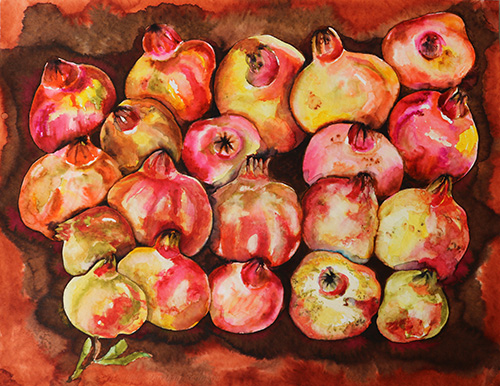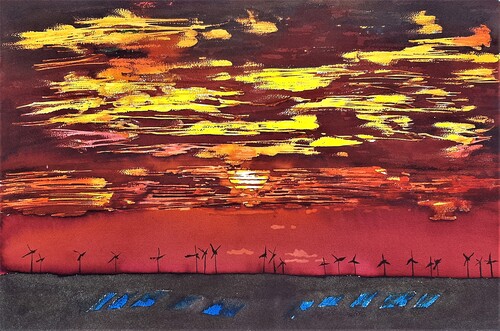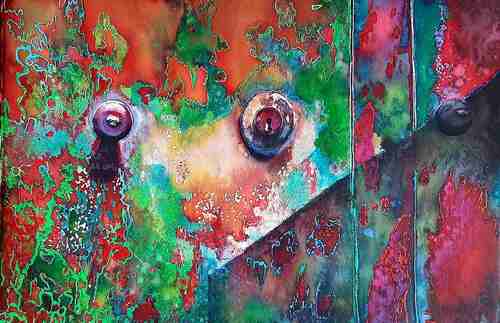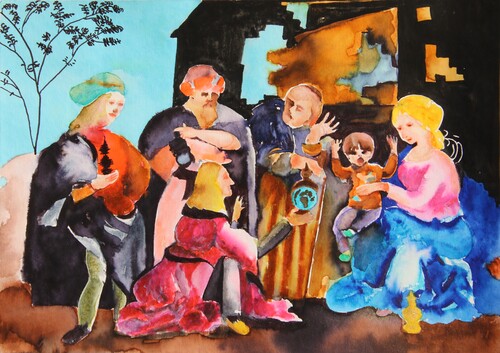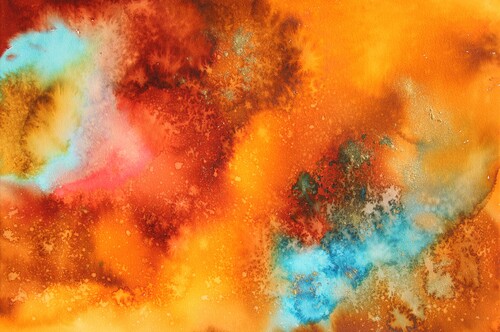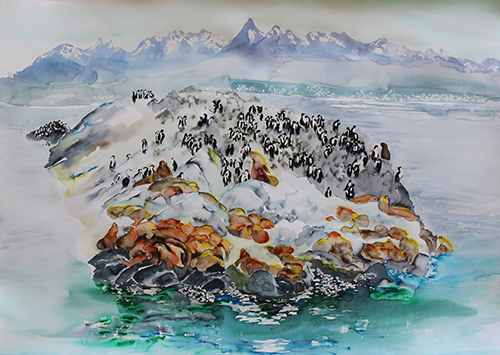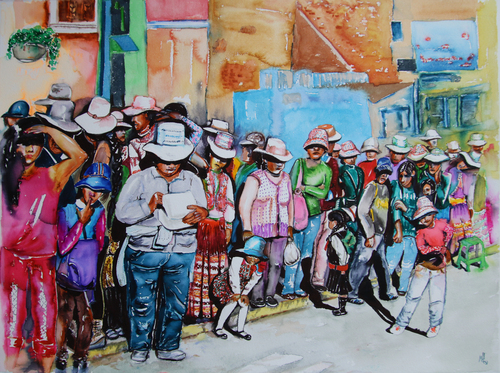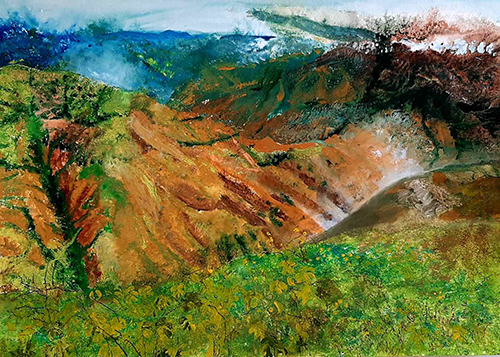Materials and techniques used: Watercolor, ink, Indian ink, charcoal, graphite and receipts on paper
I present to you two ten-meter-long and one-and-a-half-meter-high ideas, realized entirely outdoors in watercolor, ink, India ink, graphite and charcoal, a subjective objectification of the surrounding private space with a reflective reclining gaze, just as real cast shadows have done in beautiful sunny days. The natural direction of the paintings starts from the east, from the sunrise, the main exposure is the south and ends with a part of the west. North is absent, due to lack of shadows. It is preferable to look horizontally, i.e. lying on the floor, how typical objects look at themselves repeatedly. Why? Because sunlight changes its location every minute. But this is only a painterly two-dimensional effect. In general, chase and seek the full effect.
In the cardboard “The Copied Yard” the shadows of objects from the yard are alternated in real sizes: a fence net with a thuja in front of it; a canvas swing hung from a vine with ripe grapes against a background of rose petals and garden strawberries; three metal hangers-girls; two metal swan chairs in love with each other; interspersed decorative flowerpot stands; garden bench, shelters jug and tea set; a set of low table and chair of wrought iron for solitary pursuits; wooden garden fence; a wooden utility chair and a small soccer goal. On the paper you can see real prints from the garden tiles, metal safety fence and blades of grass. A yard like any yard.
We move on to the “Copied House”. For the second time, 15 square meters of roll paper with shaded images of watercolor, ink, Indian ink, graphite, charcoal, in this case also receipts, yes you read correctly – the “images” of the products in the kitchen cabinets and the refrigerator are represented by the corresponding receipts for their purchase and everything is left to your imagination. Again from the east through a long south and ending west alternate the fallen shadows of characteristic furniture and objects of a living room with a kitchenette – glasses around the sink, a mixer, hotplates, a pot, bottles, cabinets full of “products”, a refrigerator with magnets on the outside and ” products” inside, a dining table with serving dishes, various chairs around it, decorations, a glass shelf with a collection of cups, paintings on the walls (how do their shadows fall?), a window with a row of pots on the sill and shadows of visible plants from the yard , a newspaper rack, a wine bottle rack, a side table, an old model television with a kinescope, souvenirs, fantiflushes and any, or rather any mood. You say what?
There it is. There is such a moment when we seek the light where there are no shadows. In other words, we avoid any thought, feeling, or action that brings darkness into consciousness. And everyday life offers the opposite, as if we were in a daily exam. And then we instantly ask for help from Above, we turn our head to the Sun. We begin to follow its natural movement from east through south to west.
Please follow this slow motion in the two cards “The Copied Yard” and “The Copied House”. Perhaps, everyone monitors themselves all the time. It is being corrected. I’m on the mend. It changes. It is replenished. It is being upgraded. It is self-updating. It’s self-terminating. It is self-modelling. It `s developing. This seems inevitable to me. “We contact ourselves through art, says the artist Peritsa Georgiev and adds: also through breathing. Breathing is the flight of art.”
Inhale Exhale. Light, shadow. I breathe in light, I breathe out shadow. I inhale. Sun … is the shadow still there? I exhale. Rather the other way around – first I exhale, give, then inhale – receive. The world was created by exhalation or the so-called Big Bang (Big Bang). Spiritual people say that God is neither light nor darkness, God is luminous darkness.
About 2,400 years ago in The Shadow and the Cave, Plato made us imagine a situation with people chained from birth inside a cave facing a stone wall unable to move, unable to see each other, not even seeing myself. Behind the chained men on a path between them and a huge fire walk other people carrying objects on their heads, including human and animal figures made of wood, stone and other materials. The prisoners watch the shadows cast by the theater behind them, unaware that they are shadows. Shadows are the only reality they know and they take shadows to be alive and not just a reflection of reality.
The Myth of the Cave, also known as the Allegory of the Cave, Plato’s Cave, and Parable of the Cave, used by the Greek philosopher Plato in his work The State, related to Plato’s Theory of Forms or Theory of Ideas, according to which in the immaterial, abstract (but essential ) forms (or ideas), and not in the material world of changes known to us through the senses, contains the highest and most fundamental kind of reality. Only knowledge of forms constitutes true knowledge. The allegory of the cave is presented by Plato after the metaphor of the Sun and the analogy of the dividing line.
Something similar I offer you in my two cardboards “The Copied Yard” and “The Copied House”. The question is: are shadows the only reality? Do we know reality well? And do people perceive a shadowy illusion as reality?
My direction is reversed – can you imagine through the shadows reality? Shadows move, change, alter, model, transform, fade, disappear, appear. Shadows are reciprocal, inverted, recumbent, merged, spilled, dim, reminiscent, vague, reflective. What is the reality that the shadows imply? Can you mentally construct it? Can you color it similar? Are you creating a three dimensional model of the circumstance? Do you include tastes, smells, breezes, humming bees, fluttering butterflies, birdsong, and other sounds? And is the joy of the sunburn, the satisfaction of the watercolor spills, the linear concentration visible? Do you feel the creative combinability and compositional efforts? Do you find yourself drawn into more than two and three dimensions? Are we moving towards a more feeling, intuitive and perceptive multidimensional model of perception? Well, this is what we do every day and in our lives – we create our own reality with limitations, through which we explore and study ourselves, our origin, meaning and development.
The dividing line (see Plato’s Allegory of the Cave above) in both of my stories is the upper edge of the graphic drawings, because they should be viewed horizontally on the ground. The sun is always above. The point of view of the Sun is always the same. Can we escape the world of shadows (the resulting oxymoron “light of the shadows” – the word world comes from light) and find its source of light? And would this open the gap to our true light essence? Let’s talk about all this, what do you think?
This in a community. In particular, the shadows of the surrounding objects speak about my tastes, preferences, style of furnishing, atmosphere, home comfort, they unfold me in front of you like a geographical atlas, and you could figuratively imagine me, walk through my mirror world. The invisible image in the fictional visible paper plane. Reflection of reflection.
Let’s talk about that too, what do you think?


